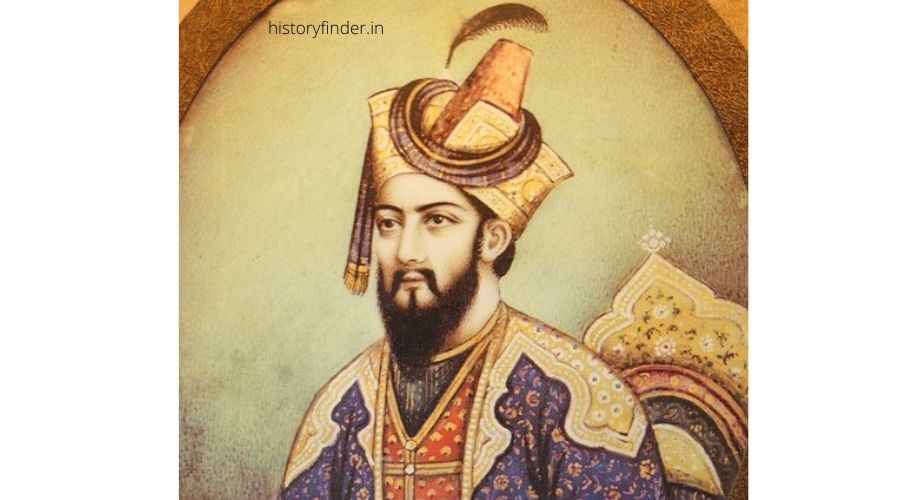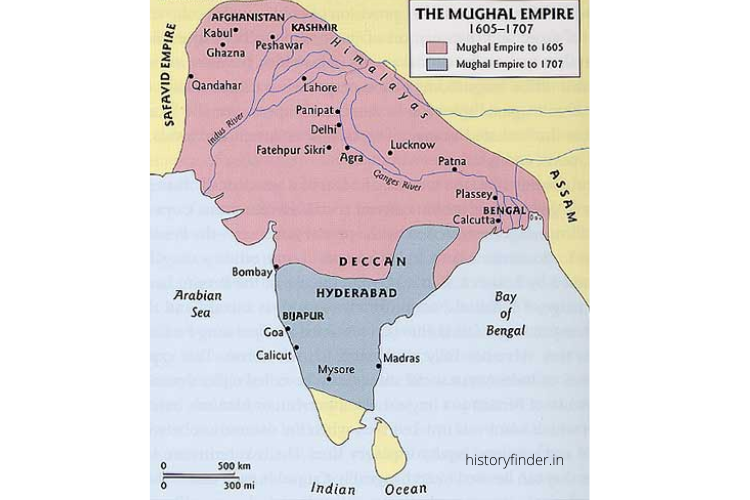The Mughals conquered India for 331 years (1526 – 1857 CE). History of India is always incomplete without the history of Mughal Empire. The dynasty, during it’s stable phase, has always focused on equality and integrity. The Mughal Emperors always tried to create an united India under it’s rule. After Gupta Empire of of 6th century, it was probably the largest empire.
The beginning of Mughal India: End of Delhi Sultanate
Before Babur founded the Mughal Empire in India, Lodi dynasty was ruling in northern India. But, in 1526 CE, Babur defeated Ibrahim Lodi, the last ruler of Delhi Sultanate in the first battle of Panipat. It eventually ended ended realm of Lodi dynasty in North India.
The Sultanate of Delhi had ruled almost entire northern India for 320 years (1206 – 1526 CE). It started from the death of Muhammed Ghori or Muhammed Ghor of Ghurid dynasty in 1206. Ghori’s slave commander, Kutub ud-din Aibak from Mamluk dynasty founded the sultanate rule in Delhi. After rule of Mamluk dynasty, other clans like Khalji, Tughlaq, Sayyid and Lodi clans had ruled in Delhi in short spans.

Babur was a great warrior who hailed from modern day Uzbekistan. He brought his immense war tactics along with advanced military weapons from central Asia. The heavy artillery guns including matchlock guns and canons was new to Ibrahim Lodi. Further, the advanced military tactics from Babur completely disarrayed the army of Ibrahim Lodi. As a result Babur was successful of demolish Ibrahim’s army. Ibrahim Lodi was trying to retreat with his surviving army. But, unfortunately Babur’s army caught and beheaded Ibrahim Lodi.
Expansion of Mughal Empire
Babur founded the Mughal Empire in India across the territories where Sultanate of Delhi were already ruling. After that he could not expand his boundaries much in India. After his sudden death in 1530, the Mughal Empire really struggled to retain their territories. During this period, the Mughals faced severe threats from the determined Rajput Kingdoms from the northern India. Apart from the Rajputs, the Afghan Suri Dynasty of north and eastern India.
Expansion of Mughal Empire under Babur
After the first battle of Panipat, Babur took control over the Sultanate of Delhi from demising Lodi dynasty. Delhi and Agra came under Babur and he formed the Mughal Empire. But, he had a very short contribution in the history of Mughal Empire in India. The first Mughal emperor ruled for just four years in India; from 1526 till 1530 CE.
During his rule in India, Babur was mostly engaged with Rana Sanga of Mewar. The Mewar Rana felt that Babur was not very keen to keep his promises. Rana Sanga took support from few Afghan chieftains to form a larger army against Babur’s Mughal army. According to the historian K. V. Krishna Rao, it was the ‘superior generalship’ of Babur to defeat Mewar Rana Sanga in the Battle of Khanwa on 16 March, 1527. The hi-tech cannons and muskets was still new in the History of Indian warfare then.
The defeat on the Battle of Khanwa, could not put stoppage on the Mewar Rana Sanga’s desire to capture Delhi and Agra. Rana Sanga again prepared his troops trying to form a joint army with Medini Rai of Malwa. Babur marched for Chanderi on receiving the news and captured the Fortress of Chanderi on 20 January 1528. After Babur captured the fortress, Medini Rai, along with other women and children committed suicide. However, Babur could not expand Mughal territories beyond Delhi and Agra.
Mughal Empire under Humayun
During the rule of the Mughal Emperor Humayun, the Mughal Sultanate suffered a huge territorial loss, especially from the Suri Empire of Sasaram of present day Bihar. However, under the rule of Mughal Badshah Jalal ud-din Akbar, the Mughals in India succeeded to recapture their lost territories. The Mughal empire further expanded during the realm of Shah-Jahan and Aurangzeb.
Expansion of Mughal Empire under Akbar
Mughal Emperor Akbar succeeded his father, Badshah Humayun in 1556, considering the death of the later. Badshah Akbar was just 14 years old when he ascended the throne of Mughal Empire. It was the commander of Mughal army, Bairam Khan who guided young Jalal ud-din until he became independent. However, in a series of battles, Mughal army recovered all the lost lands of Mughal Empire from the Suri Empire. Akbar was also successful to make a lot of Rajput ruler to accept his sovereignty under Mughal Empire.
Mughal Empire under Akbar had expanded up to the Godavari river in the southern India. Almost entire subcontinent of India came under the Mughals under Akbar the great. He also led few military campaigns towards Malwa and Gujarat. It opened up the trade route from Agra up to the Middle East countries via Jaipur and Gujarat. Akbar also had successful military campaigns towards the Himachal and brought those kingdoms and rebel powers under his sovereignty.
Mughal Emperor Akbar ruled till 1605 CE. His military expeditions ensured the spread of Mughal Empire had crossed beyond the Indus River to the west. The map below shows how much the Mughal Empire expand till 1605 under the rule of Akbar.

Expansion of Mughal Empire under Aurangzeb
Aurangzeb, the sixth Mughal Emperor, had the same goal of expanding the Mughal control over the entire Indian sub-continent. The last stable Mughal ruler had succeeded to expand further beyond the Godavari river to the south. Aurangzeb had added few more territories in the history of Mughal Empire. He successfully brought Hyderabad, Bijapur, Mysore and Madras under Mughal rule. However, after conquering Mysore and Madras, Aurangzeb couldn’t further proceed towards south. So, the dream territorial expansion over entire Indian sub-continent of the Mughals remained incomplete.
Mughal Administration
According to the great Indian historian Dr. Jadu Nath Sarkar, the Mughal Administration was not entirely based on Islamic practices. But, it presented a combination of Persian, Arabic and Indian elements put together.
History of Subahs under Mughal Empire
Mughal Emperors always believed in equal distribution of administrative power and regulations. Akbar had divided the entire Mughal Empire into 12 Subahs. The initial Subahs under the rule of Akbar were Kabul, Lahore, Multan, Delhi, Agra, Avadh, Illahabad, Bihar, Bangal, Malwa, Ajmer and Gujarat. After Akbar’s military campaign to the Deccan, 3 more Subahs (Berar, Khandesh and Aurangabad) were added. So, the final count of Subahs became 15 in the Mughal rule under Akbar.
Later on, Mughal Emperor Jahangir has added 2 more Subahs. The new Subah of Orissa was added to the Mughal Administration. The fifth Mughal Badshah Shah Jahan further increased 5 more Subahs under his rule.
Aurangzeb, the sixth Mughal Emperor, made few changes to ruling area of these Subahs under his rule. However, the total count remained the same under his rule also.
Mansabdari System under Mughal Administration
The word ‘Mansab’ is an Arabic word which means Rank or Position. It was the third Mughal ruler Akbar the great, who had introduced the Manasabdari system to the Mughal Administration. He created various Mansabs to the Mughal Administration according to the roles and responsibilities. The court of Emperor would appoint Mansabdar or officer for each Mansab. Further, Mansabdars would receive salaries and allowances according to their positions.
The Mansabdari system started by Akbar, was applicable to both civil and military administrations. Akbar had unified the salary and allowance system across all each level of Mansab. Such an well structured administration system began by Akbar later became the face of Mughal Administration.
Some historians claim that such system was also prevalent during the Mughal rule under Babur and Humayun as well. He may have inherited the system from his predecessors. But, there is no doubt that Akbar had restructured and reorganized the system to a great effect. He important values he added to the system, became extremely successful in later times.